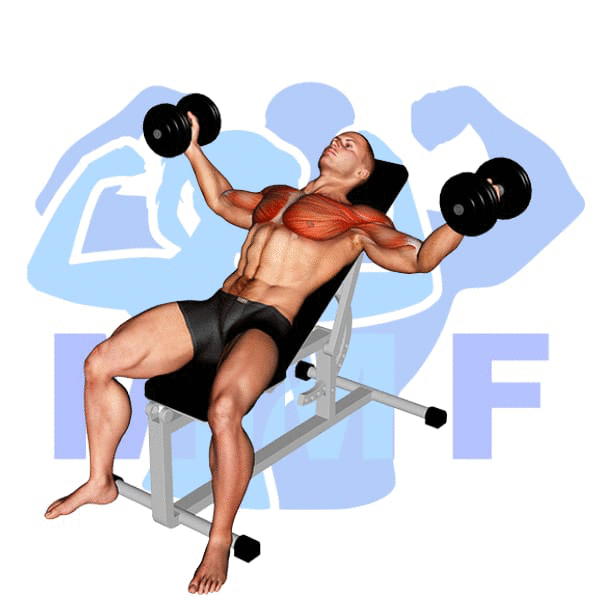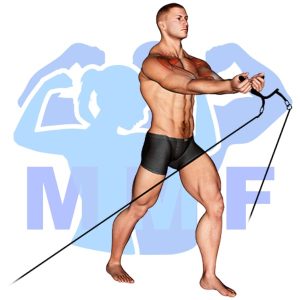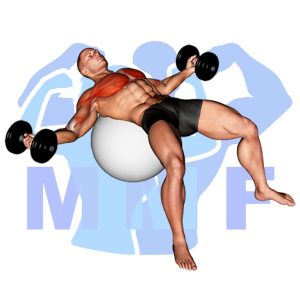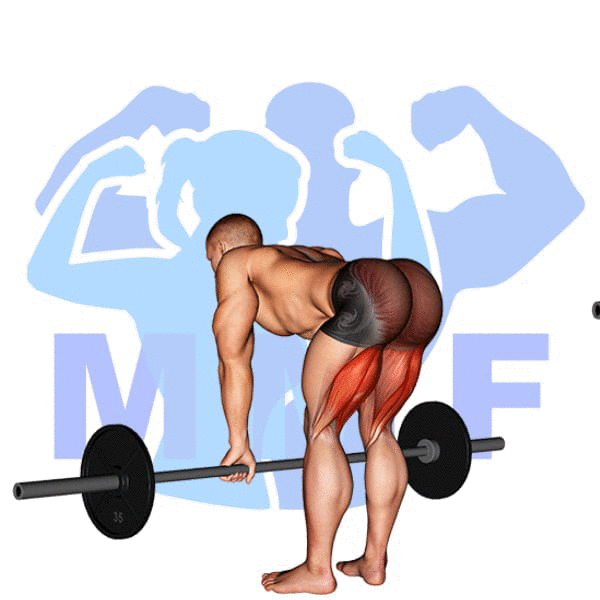Are you struggling to build your chest muscles despite putting in the effort at the gym? Are you looking for a way to target your upper pecs more directly? If so, you’re not alone. Many fitness enthusiasts find that traditional chest exercises like push-ups and bench presses don’t fully engage their upper chest muscles. Fortunately, there’s a solution that can help you achieve the chest gains you desire – the incline dumbbell fly. In this post, we’ll explore why the incline dumbbell fly is so effective for building upper chest muscles and how you can incorporate this exercise into your workout routine to get the best results.
Incline Dumbbell Fly Summary
- Primary Muscles: Pectoralis Major – Sternal
- Secondary Muscles: Latissimus Dorsi, Levator Scapulae, Pectoralis Major – Clavicular, Pectoralis Minor, and Rhomboids
- Equipment: Dumbbells and Incline Bench
- Mechanics Type: Isolation
- Force: Push
- Utility: Auxiliary

Incline Dumbbell Fly Instructions
- You should get started by picking up the dumbbells and having a seat on an incline bench.
- If you are lifting heavy, you should have a spotter, you can also get the weight up to your chest by placing them on your knees and popping them up with your legs.
- After you get the dumbbells up to your chest press them up vertically, try to minimize any movement forward or down your body.
- Pause at the top then slowly lower them back to the starting position.
- Continue to do it again completed the desired total reps.
Video Tutorial
Incline Dumbbell Fly Muscles
Target (Agonist)
- Pectoralis Major, Sternal
Synergists
- Latissimus Dorsi
- Levator Scapulae
- Pectoralis Major – Clavicular
- Pectoralis Minor
- Rhomboids
Dynamic Stabilizers
- None
Stabilizers
Antagonist Stabilizers

Benefits of Incline Dumbbell Fly
The incline dumbbell fly is a great exercise for targeting the Pectoralis Major – Sternal, which is one of the largest muscles in the chest. This exercise helps to isolate the pectoral muscle, and works to increase strength and stability in the chest. Additionally, this exercise helps to improve posture, as it works the stabilizing muscles in the shoulders and upper back. This exercise can also help to reduce shoulder impingement and improve shoulder mobility. As an added bonus, performing the incline dumbbell fly can also help to tone and shape the chest area for an overall improved aesthetic.
Tips for Performing Incline Dumbbell Fly
When you wish to develop the most effective outcomes, you must adhere to these timeless tips. Additionally, in case you are looking to minimize your likelihood of injuries, you must follow these tips.
- Push Your Lifting To Near Failing For You To Raise The Breakdown Of Your Muscular Tissues. Make sure that you have put in place effective safety precautions any time you’re pushing yourself to within failure.
- Have A Partner In Order That You Motivate Yourself Through Failing. You may only get so far without any help, a partner is able to enable you to continue your muscle tissue further than where you on your own will be able to get. Consequently you will definitely work your muscles down some more and afterward they is going to develop back bigger thru rest.
- Perform the Right Number Of Sets Utilizing Rest. Your target in the beginning might be to do 3 sets to near fatigue. However, you can build up to 5 sets. If your muscles aren’t exhausted at the conclusion of 3 – 5 some thing needs to change. Initially you can increase the resistance to make each repetition tougher. Additionally, you can decrease the rest time between your sets.
- Concentrate On Your Breathing. With this and most exercise movements respiration is important. You have to be exhaling out during the target muscle flexing and breathing in when your primary muscles are relaxing.
Benefits and Tips Video
Frequent Mistakes To Avoid
You ought to stay clear of these typical errors to build and maintain ideal form and see large gains. As well, when you refrain from these problems you will lessen the chance of receiving injuries.
- Try Not To Make It To Easy. Your only way to improve strength will be to challenge yourself.
- Don’t Cheat. In nearly all cases, cheating is applying momentum as a substitute for the force of your agonist (target) muscle. Once in a while, a little cheating on your last rep can be great to overload your muscle, however not for more than one or two reps.
- You Must Not Neglect Your Cooldown. You would have longer recovery time and more soreness whenever you miss your cooldown.
Find More Dumbbell Exercises Here
Variations and Complementary Exercises
When looking for variations, complementary, or alternative exercises for the exercise Incline Dumbbell Fly, there are a few that come to mind. These exercises work similar muscles as the exercise Incline Dumbbell Fly, so you can be sure you’re still targeting the same areas. Here are some of the best options:
Incline Dumbbell Twisted Flyes

Incline Dumbbell Twisted Flyes are an effective alternative or complementary exercise to the classic Incline Dumbbell Fly. This variation focuses on the external rotators of the shoulder, adding extra stability and strengthening to the shoulder joint and muscles. The movement begins with the arms out to the sides and bent at a 90 degree angle. The palms face each other and the elbows are slightly bent. From here, the arms come together in a twisting motion, emphasizing the external rotation of the shoulder muscles. As the arms come together, the palms should now face the floor, and then the arms are reversed back to the starting position. This exercise is a great way to increase shoulder stability while still targeting all of the major muscles involved in the Incline Dumbbell Fly.
Low Cable Fly

The Low Cable Fly is a great complementary or alternative exercise to the Incline Dumbbell Fly. It targets the same muscle group but with a slightly different angle. The Low Cable Fly requires the user to stand in between two low pulley machines, with their arms extended out to the sides and elbows slightly bent. From this position, the user will bring their hands together in front of their chest and return back to the starting position. This exercise is great for developing the chest muscles and helping to increase overall strength.
Lying Cable Flys

Lying Cable Flys are an excellent complementary exercise for Incline Dumbbell Flys. This exercise is performed on a cable machine, with the arms extended straight out in front of the body. The arms then come together at the top, like a hugging motion, and then return to the starting position. This exercise focuses on the upper chest and shoulders, while also incorporating some core stability. The cable machine also adds a unique element of resistance to the exercise that dumbbells cannot provide. It is an excellent alternative for those who want to work their chest and shoulders but do not have access to dumbbells.
Check Out These Top Dumbbell Exercises
Stability Ball Cable Flys

Stability Ball Cable Flys are a great complementary or alternative exercise to the Incline Dumbbell Fly. This exercise targets the chest muscles and helps to build both strength and stability. The stability ball adds an additional challenge to the exercise, as it forces the core to work harder to maintain balance while performing the exercise. To perform this exercise, lie on the stability ball with your feet firmly planted on the ground, and grab the cable handles. Start in a bent arm position and then extend your arms outward, contracting your chest muscles as you do so. Return to the starting position and repeat for desired reps.
Stability Ball Dumbbell Fly

The Stability Ball Dumbbell Fly is a great complementary or alternative exercise to the Incline Dumbbell Fly. This exercise works the same muscles as the Incline Dumbbell Fly but adds an extra challenge of stability. You start in a push-up position with your hands on the ball and feet on the floor. Then you lower your body down towards the ball and press back up to start position. The instability of the ball will force you to engage your core and stabilize your body throughout the movement. This will add an extra level of intensity to the exercise and help you achieve better results.
Stability Ball Incline Dumbbell Fly

The Stability Ball Incline Dumbbell Fly is a great alternative or complementary exercise for the Incline Dumbbell Fly. It involves lying on an incline bench with your feet on a stability ball. You then press the dumbbells up and out to the side, keeping your elbows slightly bent and engaging your core muscles. This exercise is great for targeting your chest, shoulders and triceps while also building strength and stability in your core. The instability of the ball allows you to work multiple muscle groups at once, making it an effective exercise to incorporate into any strength training program.
Find More Chest Exercises Here
Opposing Complementary Exercises
The Incline Dumbbell Fly is a great exercise for targeting the upper chest muscles. To maximize the benefits of this exercise, it is important to also target the opposing muscle groups. Here are some exercises that will help you do just that:
Barbell Rear Delt Raise

The Barbell Rear Delt Raise is a great complementary exercise to the Incline Dumbbell Fly, as it targets the opposing muscle group. This exercise works the rear deltoids, which are the muscles located at the back of the shoulders. This exercise is great for adding width to the shoulders and can be done with either straight arms or bent arms, depending on which variation you prefer. The Barbell Rear Delt Raise is performed by standing with your feet shoulder-width apart and holding a barbell with an overhand grip. You then raise your arms up until they are parallel to the floor, feeling the contraction in your rear deltoids. This exercise pairs perfectly with the Incline Dumbbell Fly, as it strengthens and develops the opposing muscle group to create a balanced physique.
Cable Crossover Reverse Flys

Cable Crossover Reverse Flys are a great complement to Incline Dumbbell Flys, as they target the opposing muscle group. This exercise specifically targets the posterior deltoids and the rhomboids, which are responsible for the pulling motion of the shoulder blades. It also engages the traps, lats and rear delts, allowing for a full range of motion. The Cable Crossover Reverse Flys help to bring balance to the body, as Incline Dumbbell Flys target the chest muscles and front delts. By using both of these exercises, you can achieve a complete upper body workout and build strength, stability and symmetry in your shoulders.
Dumbbell Bent Over Row

The Dumbbell Bent Over Row is a great exercise to complement the Incline Dumbbell Fly. This exercise works the opposing muscle group of the chest, the back muscles. It targets the lats, traps, rhomboids and rear deltoids, allowing for a balanced upper body workout. It also helps to improve posture and strengthen the back, which can help to reduce the risk of injury. When done properly, it can provide a great workout for all the major muscle groups in the back. By doing this exercise in conjunction with the Incline Dumbbell Fly, you can achieve a well-rounded and balanced workout for your upper body.
Ready to Fly High with Incline Dumbbell Flys
Ready to take your chest workouts to new heights? Incline dumbbell flys are a great exercise that targets the upper portion of your chest, helping you sculpt and define your pecs. Once you have perfected your form and have built up enough strength, you’ll be ready to soar to new heights with this challenging exercise. Keep in mind that proper form is crucial to avoid injury and maximize benefits. So, always start with a weight that is comfortable and gradually increase as you build your strength and confidence. With consistent practice, you’ll be on your way to achieving your fitness goals and soaring to new heights.
References: Wikipedia | ExRx.net | PubMed.gov | Comprehensive List of Chest Dumbbell Exercises




